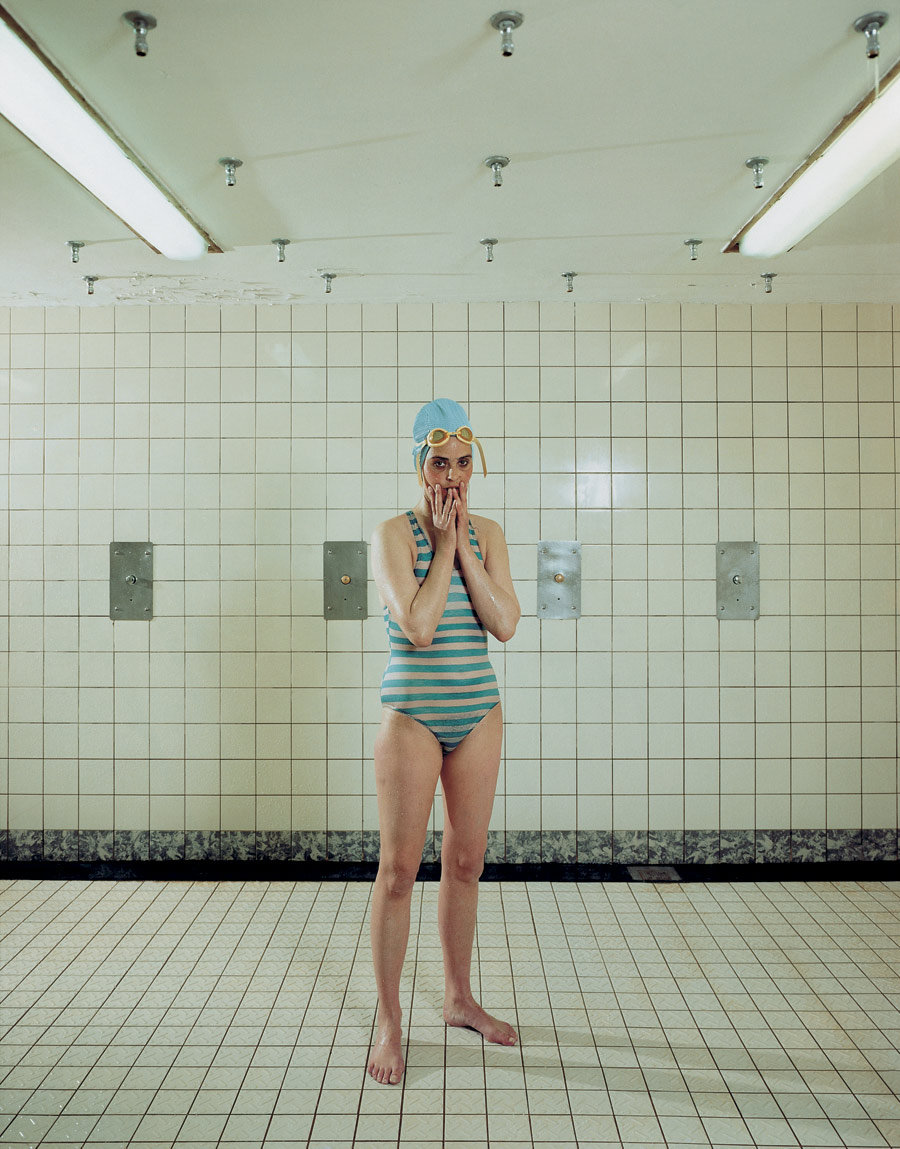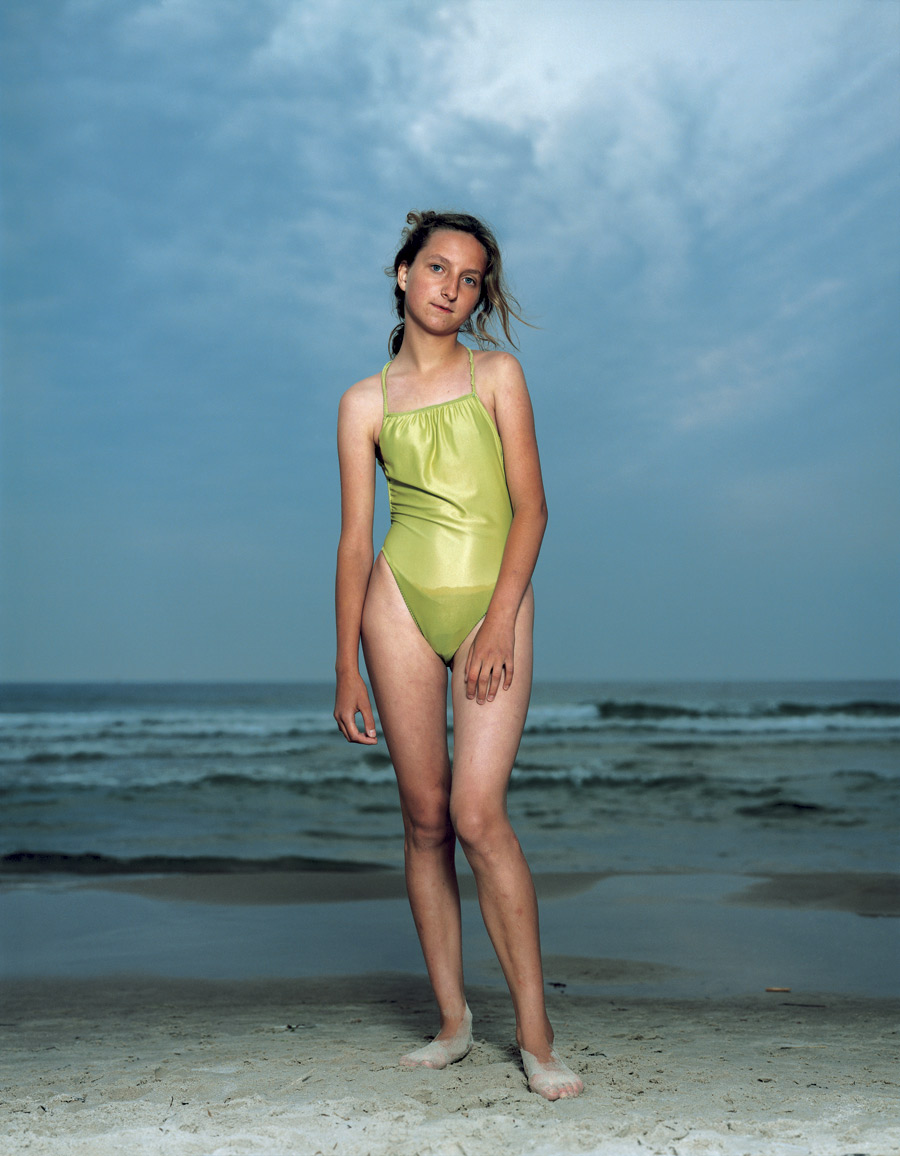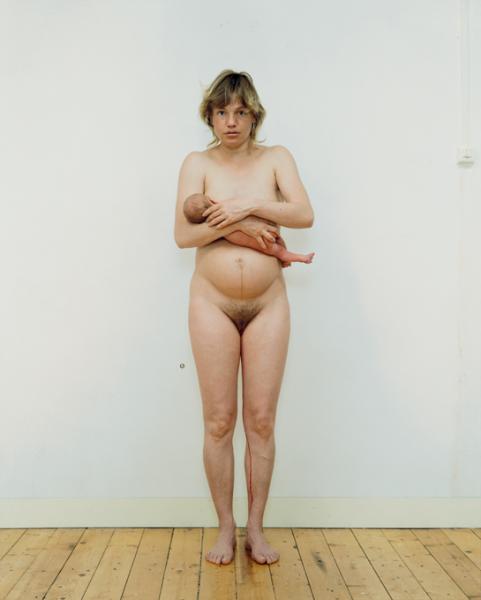 |
| Self Portrait, Marnixbad, 1991 |
Rineke was born in Sittard, the Netherlands, in 1959. She studied photography at the Gerrit Rietveld Academie in Amsterdam from 1981 to 1986. Since her first solo exhibitions at de Moor in Amsterdam in the early 1980s, Dijkstra has shown at museums and galleries across the world. She has received wide recognition and numerous awards for her work, including the Kodak Award Nederland, the Art Encouragement Award Amstelvee, the Werner Mantz Award, and the Citibank Private Bank Photography Prize. Guggenheim
Rineke works in series, creating groups of photographs and videos around a specific typology or theme. In 1992, she started making portraits of adolescents posed on beaches from Hilton Head, South Carolina, to Poland and Ukraine. Shot from a low perspective, the subjects of the Beach Portraits (1992–2002), poised on the brink of adulthood, take on a monumental presence. In contemporaneous works, including portraits of new mothers after giving birth, and photographs of bullfighters immediately after leaving the ring, she sought subjects whose physical exhaustion diminished the likelihood of a forced pose. Guggenheim
Beach Portraits
 |
| Kolobrzeg, Poland, 1992 |
 |
| Hilton Head Island, USA, 1992 |
 |
| Cezanne, The Bather, 1886 |
In an interview with the New York Times in November 2012 the street/documentary photographer Joel Meyerowitz talked about his photography and on whom it had influenced:
"Rineke Dijkstra said that Mr. Meyerowitz’s work was a “real eye-opener” for her as a student in Amsterdam in the 1980s. Like many other young European photographers, she was still working in black-and-white, but Mr. Meyerowitz’s complex way with light in seemingly straightforward pictures of swimming pools and beaches helped her understand the power of colour" NY TimesMeyerowitz had exhibited these photos in Amsterdam in 1983, the same time Dijkstra was a student. Looking at two of Meyerowitz's images makes the links between both series much easier to see:
New Mothers
This is a series of three portraits of women made shortly after they had given birth. All the women were known to the artist – one was a personal friend and the other two were friends of friends. Dijkstra photographed the women in their homes because in Holland it is more common for women to give birth at home than in a hospital. While bearing signs of their recent ordeal – the medical pants and sanitary towel which Julie wears, a trickle of blood down the inside of Tecla’s left leg, the caesarean scar on Saskia’s belly – the women appear proud and happy. They hold their new babies turned away from the camera, protectively pressed against their bodies. Dijkstra has developed a way of combining natural light with flash which results in particular quality of soft, clear light. Julie’s left hand covers her baby’s eyes to protect them from the flash. TATE
 |
| Julie, Den Haag |
Dijkstra was inspired to make these portraits after watching the birth of a friend’s baby. She is interested in photographing people at a time when they do not have everything under control. She uses the device of the formally posed, full-length portrait to try to reveal something of what people carry inside them – the emotional intensity concealed behind the mask of the face and the body’s pose.
The photographic portrait, titled with the date and place, records a specific moment in time in which the subject was undergoing a particular experience. Dijkstra has commented:
 |
| Tecla, Amsterdam |
The photographic portrait, titled with the date and place, records a specific moment in time in which the subject was undergoing a particular experience. Dijkstra has commented:
"As a photographer you enlarge or emphasize a certain moment, making it another reality. For instance the portraits I made of women after giving birth: the reality of this experience is about the whole atmosphere, which is very emotional. In the photograph, you can scrutinize all the details, which makes it a bit harsh: you can see things you normally would not pay so much attention to." (Dijkstra, 2003)
 |
| Saskia, Harderwijk |
Israel Portrait
This is one of my favourite series of Rineke's work. Shany, a young Israeli women, is recorded at stages over the course of 18 months, from her first day in uniform in the Israeli Defence Force until after she quit the army.
 |
| Shany: Induction Centre March 2002 Palmahim Israeli Air Force Base Oct 2002 |
 |
| Tel Hashomer May 2003 Herzliya August 2003 |
This is one of my favourite series of Rineke's work. Shany, a young Israeli women, is recorded at stages over the course of 18 months, from her first day in uniform in the Israeli Defence Force until after she quit the army.
As usual with Ms. Dijkstra, the photographs are simple, head-on figures against plain backdrops, the subjects staring passively at the camera, presenting themselves as they wish, or trying to. They look alert but just on the edge of fatigue or distraction, which means their guard is almost down. They grow up over the course of each series. Shany changes from a gawky, shy, frightened girl, lost in her uniform, into a young adult, looking confidently at us, an independent, even defiant woman who has shed her uniform. NY Times
I think it is interesting the way that the subject seems to make a yo-yo progression in confidence as the series evolves. The initial gawkiness is replaced with a seemingly calm confidence in only a few months. In the third image Rineke has again placed her subject outside against a wall and the previous confident air has dissolved. It may be something as simple as the pose of the mouth as,for me, the gap in the teeth takes away the 'harshness' of the backdrop and military uniform. This series has received mixed reviews with GALO Magazine's critic being typical of those who found the series uninspiring.
More information, books and contact details:
A great video discussion of Rineke's work, with some segments by the artist, can be found on the Guggenheim website HERE. The video moves on to discuss some of Rineke's video work, an interesting take on the portrait genre. There is also a LINK to a second video in which Rineke and one of her subjects, Almersia, talk about her work and the shooting process.
Books:

Retrospective £29 approx
"This volume is the first comprehensive monograph on Rineke Dijkstra to be published in the United States, accompanying the first U.S. mid-career survey of this important Dutch artists work in photography and video. The catalogue features the Beach Portraits and other early works such as the photographs of new mothers and bullfighters, together with selections from Dijkstras later work, including her most recent video installations. Also featured are series that the artist has been working on continuously for years, such as Almerisa (1994), which documents a young immigrant girl as she grows up and adapts to her new environment. Exhibition curators Jennifer Blessing, Senior Curator, Photography, Solomon R. Guggenheim Museum, and Sandra S. Phillips, Senior Curator of Photography, San Francisco Museum of Modern Art, contribute essays accompanied by an interview with the artist by Jan van Adrichem, selected interviews with several of the artists subjects, and entries on the artists series by Chelsea Spengemann, as well as the most comprehensive exhibition history and bibliography to date."

Portraits if you have more money as it's currently £110!
Rineke Dijkstra is renowned for her uncanny and thoughtful portraits series of teenagers and young adults: girls and boys of various nationalities at the beach, children of Bosnian refugees, Spanish bullfighters straight out of the arena, Israeli youngsters before and after military service, and here, documented for the first time, her series of photographs taken of aspiring, young ballet dancers. Her subjects are shown standing, facing the camera, against a minimal background. Formally, the images resemble classical portraiture with their frontally posed figures isolated against minimal backgrounds. Yet, in spite of the uniformity in the photographer's works, there is a marked individuality in each of her subjects. Dijkstra often deals with the development of personality as one moves from adolescence to adulthood, or through a life-changing or potentially threatening experience such as childbirth, or a bullfight.Portraits includes the photographer's new Ballet School series. In the end, it's the individual that I'm after.There is a video of the Portraits book on Youtube (not sure about the music though!):
--Rineke Dijkstra Essays by Urs Stahel and Hripsimé Visser. Hardcover, 9.75 x 13 in./160 pgs / 69 color.
Like Rineke on FACEBOOK
Rineke talks to The Guardian newspaper about her best shot
If you are really interested in how Rineke works and her inspirations and techniques there is an hour long video of her being interviewed by Jennifer Blessing, the Curator of the Guggenheim New York. You can find the video on Vimeo HERE.




The photograph "Caroline, Provincetown, Massachusetts, 1983" is by Joel Meyerowitz - see it here
ReplyDeletehttp://www.photo.fr/img/article/4/1/1/6/6114/6114.jpg
And this is "Eliza, Provincetown, 1982" from the same Meyerowitz series:
http://www.jacksonfineart.com/images/artists/large/2522.jpg
I think this work probably inspired Rineke Dijkstra's photos of awkward adolescents on beaches. In an interview in November last year she said that Joel Meyerowitz’s work was a “real eye-opener” for her as a student in Amsterdam in the 1980s, and that Meyerowitz’s photographs helped her understand the power of color.. Meyerowitz himself has said “I exhibited these photographs in 1983 in Amsterdam. I'm not saying they were an inspiration for her [Dijkstra], but these photographs were out there. At the time, color portraits weren’t very welcome in galleries or museums.”
Thanks for this great extra information ammgramm. I've taken the liberty to update the main article with links to the interview you talk about and the two photos you have mentioned. Keep this sort of thing coming readers!
Delete